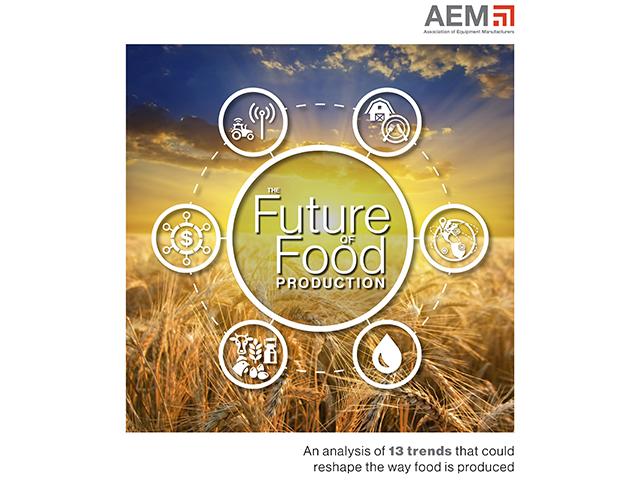We'd Like To Mention
These Trends Will Define Food Production
Farmers and ranchers know they must adapt to ever-changing challenges to survive and thrive. New thinking. New ways of doing business. Embracing innovation. All are critical to continued success today and into the future.
The Association of Equipment Manufacturers (AEM) recently released the "Future of Food Production," which provided an analysis of 13 trends that will likely reshape agriculture over the next 10 years. Here are seven of the most compelling trends.
-- Shorter Food Supply Chain. The pandemic and supply chain disruptions have refocused attention on locally sourced food and diversifying suppliers. Major retailers are increasing investments in vertical farming to be closer to certain food supplies. As more consumers and institutions look to their communities for reliable sources of food, the shift will add strain on an already-shrinking skilled workforce.
-- Geographic Shift in Production. Climate change and water resource challenges will redraw crop-growing regions. We already see farmers in southern Kansas planting cotton. Penn State University research suggests if warming of the Midwest remains unabated, the best conditions for growing corn could shift northward from Illinois and Iowa to the Dakotas and Minnesota. I-state farmers may have to adapt to a warmer climate by producing two crops in the same year or moving away from a corn-soybean rotation.
P[L1] D[0x0] M[300x250] OOP[F] ADUNIT[] T[]
-- Farmers Adjust in Response to Emission Regulation. Reducing greenhouse gas (GHG) emissions is taking on new urgency, from regulatory agencies to state and federal governments. Shareholders are also demanding companies do their part to cut GHG emissions. Biofuels -- ethanol, soy diesel, renewable diesel fuel, etc. -- will all play a growing role. Other alternative energies, including solar, wind, anaerobic digesters, biomass and more, recently received a $464-million boost from USDA to encourage farmers and rural communities to use renewable energy. Advances in methane- and electric-powered engines and hydrogen fuel cells will also evolve to decrease dependence on fossil fuels.
-- Efforts to Decarbonize Create Adjacent Economies. Opportunities to participate in various carbon-sequestration programs will create new revenue streams for farmers while helping to enhance environmental sustainability. Work will need to continue to standardize and regulate carbon marketplaces to reward farmers for their commitment to capturing carbon.
-- Resources Pour Into Cybersecurity. Advances in precision agriculture, artificial intelligence, machine learning and data collection and automation will be invaluable for insights-driven farming to improve productivity and efficiencies using sustainable practices. Unfortunately, as operations become more connected, they become more vulnerable to hacking. Cybersecurity will become synonymous with food security across the entire food chain, especially on the farm.
-- Farm Ownership Models Change. The decoupling of land ownership and farm operation will accelerate. New landowners may look at the landowner/tenant relationship in an entirely different light, focusing more on maximizing annual return on investment instead of a longer-term view. Growers will need to use their knowledge and expertise in productivity, efficiency and stewardship to forge successful partnerships with these new landowners.
-- New Business Models Emerge. Farmers will be able to reinvent themselves and pivot risk. For example, they may see value in shifting equipment from capital expenditure to operating expenditure. Equipment-as-a-Service lets farmers lease equipment for a specified period. Payment is based on actual output of that equipment along with any other services, such as data analytics and preventative maintenance. The custom-farming business model allows farmers to farm more acres without assuming the additional risk of owning or leasing more land. Another transformative shift will be outcome-based pricing models, where programs guarantee a certain metric or outcome, such as yield. If it's not reached, farmers receive a refund or credit.
**
FOR MORE INFORMATION:
-- For the complete report, visit https://www.aem.org/…
-- Write Gregg Hillyer, 2204 Lakeshore Dr., Suite 415, Birmingham, AL 35209, email gregg.hillyer@dtn.com, or follow Gregg on Twitter @GreggHillyer
[PF_1022]
(c) Copyright 2022 DTN, LLC. All rights reserved.




